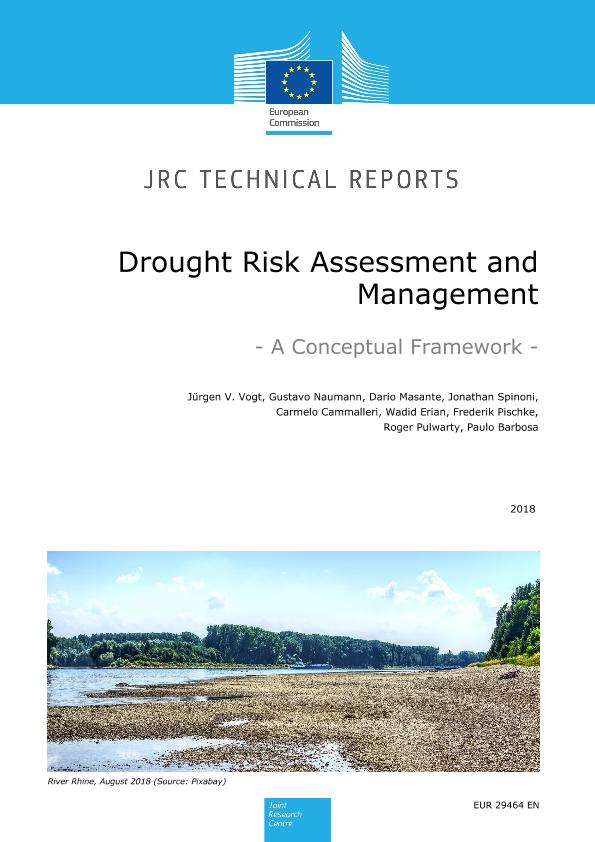Mostrar el registro sencillo del ítem
dc.contributor.author
Vogt, Jürgen V.
dc.contributor.author
Naumann, Gustavo

dc.contributor.author
Masante, Darío
dc.contributor.author
Spinoni, Jonathan
dc.contributor.author
Cammalleri, Carmelo
dc.contributor.author
Erian, Wadid
dc.contributor.author
Pischke, Frederik
dc.contributor.author
Pulwarty, Roger
dc.contributor.author
Barbosa, Paulo
dc.date.available
2022-07-19T12:20:38Z
dc.date.issued
2018
dc.identifier.citation
Vogt, Jürgen V.; Naumann, Gustavo; Masante, Darío; Spinoni, Jonathan; Cammalleri, Carmelo; et al.; Drought risk assessment and management: A conceptual framework; European Union; 2018; 64
dc.identifier.isbn
978-92-79-97469-4
dc.identifier.issn
1831-9424
dc.identifier.uri
http://hdl.handle.net/11336/162467
dc.description.abstract
In the context of global warming, droughts are increasingly threatening our societies. They last for months or even years, affecting wide areas and large numbers of people, with single drought events sometimes causing economic damages for several billion Euros. Besides the economic damages, droughts can compromise ecosystems and threat food security in the most vulnerable countries.To reduce drought impacts, drought risk assessments need to be implemented in order to support policy makers and water managers in developing coping strategies and drought management plans. Due to the wide-ranging direct and indirect, often cascading impacts, drought risk assessments need to include information tailored to specific sectors and oriented to the needs of specific users.Drought risk as defined here is the likelihood to incur damages and economic losses during and after a drought and depends on the interactions between three dimensions:1) the severity and the probability of occurrence of a certain drought event, 2) the exposed assets and/or people, and3) their intrinsic vulnerability or capacity to cope with the hazard.The characterization of these dimensions and the representation of their interactions over different socio-economic sectors poses several challenges. This document discusses these challenges and proposes a theoretical framework to assess drought risk at global scale in order to provide policy relevant information. Based on the described conceptual approach, the JRC developed the Global Drought Observatory (GDO) as a first operational dynamic drought risk monitor for the entire globe.The report is structured as follows:Firstly, the causes and characteristics of drought events as well as their link with climate variability and climate change are discussed (chapters 1 and 2).Secondly, the concept of drought risk is presented, including a first approach to map drought risk at global scale as a function of hazard, exposure and vulnerability (chapter 3). This framework is then linked to expected impacts in different economic sectors and the environment, including the discussion of case studies from Argentina, South Africa, Syria and the United States (chapter 4).Finally, a brief introduction to the key aspects of drought risk management and an outlook on future challenges and opportunities are presented in chapters 5 and 6.
dc.format
application/pdf
dc.language.iso
eng
dc.publisher
European Union
dc.rights
info:eu-repo/semantics/openAccess
dc.rights.uri
https://creativecommons.org/licenses/by-nc-sa/2.5/ar/
dc.subject
DROUGHT
dc.subject
RISK
dc.subject
ASSESSMENT
dc.subject.classification
Investigación Climatológica

dc.subject.classification
Ciencias de la Tierra y relacionadas con el Medio Ambiente

dc.subject.classification
CIENCIAS NATURALES Y EXACTAS

dc.title
Drought risk assessment and management: A conceptual framework
dc.type
info:eu-repo/semantics/publishedVersion
dc.type
info:eu-repo/semantics/book
dc.type
info:ar-repo/semantics/libro
dc.date.updated
2022-07-15T15:01:39Z
dc.journal.pagination
64
dc.journal.pais
Luxemburgo

dc.journal.ciudad
Luxemburgo
dc.description.fil
Fil: Vogt, Jürgen V.. European Commission. Joint Research Centre; Bélgica
dc.description.fil
Fil: Naumann, Gustavo. Consejo Nacional de Investigaciones Científicas y Técnicas. Oficina de Coordinación Administrativa Ciudad Universitaria; Argentina. European Commission. Joint Research Centre; Bélgica
dc.description.fil
Fil: Masante, Darío. European Commission. Joint Research Centre; Bélgica
dc.description.fil
Fil: Spinoni, Jonathan. European Commission. Joint Research Centre; Bélgica
dc.description.fil
Fil: Cammalleri, Carmelo. European Commission. Joint Research Centre; Bélgica
dc.description.fil
Fil: Erian, Wadid. European Commission. Joint Research Centre; Bélgica
dc.description.fil
Fil: Pischke, Frederik. European Commission. Joint Research Centre; Bélgica
dc.description.fil
Fil: Pulwarty, Roger. European Commission. Joint Research Centre; Bélgica
dc.description.fil
Fil: Barbosa, Paulo. European Commission. Joint Research Centre; Bélgica
dc.relation.alternativeid
info:eu-repo/semantics/altIdentifier/doi/http://dx.doi.org/10.2760/057223
dc.relation.alternativeid
info:eu-repo/semantics/altIdentifier/url/https://op.europa.eu/en/publication-detail/-/publication/55fa1d08-fc2e-11e8-a96d-01aa75ed71a1/language-en
dc.relation.alternativeid
info:eu-repo/semantics/altIdentifier/url/https://publications.jrc.ec.europa.eu/repository/handle/JRC113937
Archivos asociados
